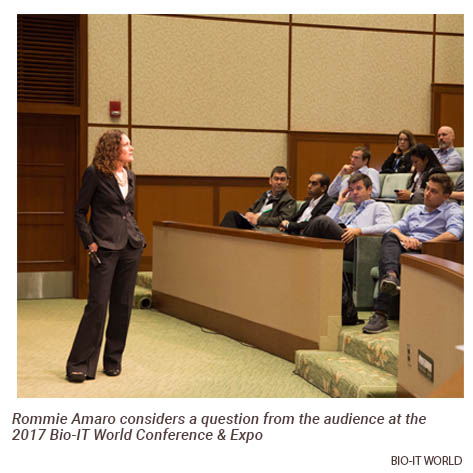Rommie Amaro on Curing Cancer at Exascale
By Joe Stanganelli
June 1, 2017 | In her opening plenary keynote at the 2017 Bio-IT World Conference & Expo last week in Boston, Computing Cures: Discovery Through the Lens of a Computational Microscope, Rommie Amaro emphasized to attendees the direct correlation between advances in life-sciences IT and scientific discovery.
“I probably don't need to remind folks in here how computing is transforming biomedical research,” Amaro began. “We've been keenly interested in trying to harness this extraordinary growth in computing power to answer questions… in human health and biology.”
Amaro is both a chemistry professor at University of California, San Diego as well as cofounder of San Diego biotech firm Actavalon. Amaro reported that, each year, the computing power available to her and her research teams has increased “by an order of magnitude”—allowing for Amaro and her colleagues to study and make new discoveries in systems as small as a mere 500,000 atoms—or a single protein. She further reported that, similarly, the timescales in which they have been able to study atoms are “routinely” as small as hundreds of microseconds (1 second = 1,000,000 microseconds) —and can even extend down to hundreds of picoseconds (1 microsecond = 1,000,000 picoseconds).

“These technologies are becoming more and more accessible and more and more easy for people to operate even on their own laptops, and make scientific discoveries,” said Amaro. “This is going to bring us into sustained exascale computing performance.”
The Long Hello: Entering the Exabyte Age
Amaro is not the first Bio-IT World presenter to predict the coming age of exascalability in life-science research and elsewhere. In his own Bio-IT World Conference keynote five years ago, then-CIO of the Broad Institute Martin Leach told attendees that, by 2035, they could expect to be able to buy a consumer-grade hard drive bearing nearly 16 exabytes of capacity for only $50.
That's to say nothing of enterprise-grade storage. On that note, Chris Gladwin, then CEO of storage-solutions firm Cleversafe, made predictions yet more bold than Leach's two years later at a sponsor dinner at the 2014 Bio-IT World Conference Expo. There, he delivered the twofold prediction that, by 2024, (1) enterprises in healthcare and life science will already be in the zettabyte age (1 zettabyte = 1,000 exabytes) and (2) enterprise storage drives with sub-petabyte capacities “won't exist.”
More to the point, Gladwin also told the packed dining room that Cleversafe had already acquired exabyte customers. (That's customers—plural.)
Two years after that, in a workshop at last year's Bio-IT World Conference & Expo, NCI cancer-informatics chief Tony Kerlavage prognosticated that, by 2018, production of NGS data would crest the two-exabyte mark (presuming that has not happened already). To put that in perspective, for the past few years, daily data production globally—not just in healthcare and life science—has been on the order of a few exabytes per day.
As genomics has gradually been approaching the halfway mark on the world's already tremendous daily data creation, and other healthcare and life-science areas likewise take their lion's share of data, computational abilities have had to keep up—leading to veritable breakthroughs in scientific research.
Powering a Possible Cancer Cure
Amaro illustrated how computational advancements have advanced drug discovery and precision medicine in particular by delving into the details of a particular protein: p53.
P53, Amaro explained, is a tumor-suppressor protein that senses stress and damage to cells and regulates mechanisms related to cell death. More than 50% of all people with cancer have a mutated p53 gene. As such, scientists like Amaro believe that p53 could unlock the secrets of curing cancer.
Unfortunately, said Amaro, experimental limitations have historically hindered p53 research—particularly illustrated in a 2009 study investigating covalent attachments of molecular attachments to p53. Since then, Amaro said, advancements in computational power allowing simulations to help uncover new leads on sites available for covalent binding have drastically improved researchers' understanding of p53 mutations—including that of Amaro's own team at Actavalon.
"With this early success… we significantly expanded the approach to see if we could develop our own compounds that would activate p53," said Amaro. "We've documented millions of compounds… We now have many multiple dozens of compounds that are reactive and—they're specific for particular p53 mutant forms."
In addition to computational advancements, Amaro also heavily focused on how her colleagues have leveraged improvements in high-resolution imaging—allowing better visualization at the molecular level. In particular, Amaro credited sponsorship by GPU manufacturer Nvidia.
"[I]t turns out that these same technologies [for realistic video-game graphics] are very highly amenable to the types of mathematical computations that we're doing," said Amaro. "We use integrative modeling where we can link to [and] combine multiple high-resolution structures and low-resolution… microscopy to get a sense of what … these systems look like—but still maintain the [visual] detail."
Technology specifics aside, Amaro went on to ring the familiar bell of Bio-IT keynotes—that the missing piece at the intersection of life-science research and life-science IT remains collaborative data sharing.
"The story with p53's great, but it's going to take more than just my lab working on one target to really make inroads into cancer," said Amaro. "We need to develop technologies that [make data] freely accessible… so that researchers all over the world can take them and do their own studies."


